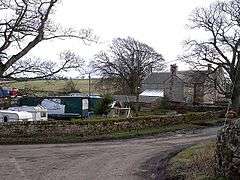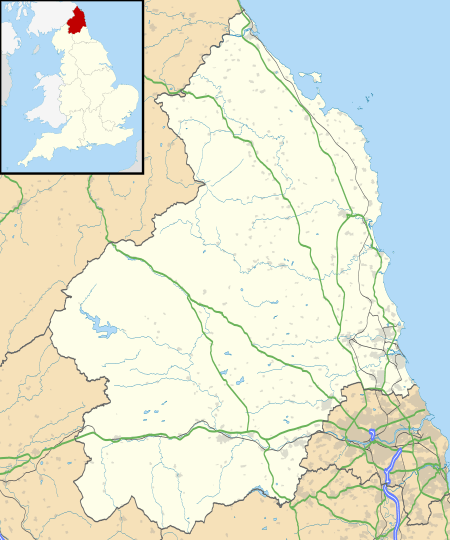Bingfield
Bingfield is a village in Northumberland, in England. It is situated to the north of Corbridge, off the A68 road and includes some properties situated on the A68 (Dere Street).
| Bingfield | |
|---|---|
 Bingfield | |
 Bingfield Location within Northumberland | |
| OS grid reference | NY975725 |
| Unitary authority | |
| Ceremonial county | |
| Region | |
| Country | England |
| Sovereign state | United Kingdom |
| Post town | NEWCASTLE UPON TYNE (parts) and HEXHAM (parts) |
| Postcode district | NE19 and NE46 |
| Dialling code | 01434 |
| Police | Northumbria |
| Fire | Northumberland |
| Ambulance | North East |
| UK Parliament | |
Modern history of Bingfield
Bingfield likely developed from a farming community in the early 19th century, since most of the buildings date to that era. There were probably four farms: the present farm at the bottom of the road (now owned by the Whites and Sistersons); the Scott's farm, located about half a mile from Bingfield Combe Cottage, which consists of a massive farmhouse and several barn houses, now converted into homes. There is a smaller farm fifty yards opposite from the original farmhouse at the bottom of the hill, which was owned by the Scotts and Bingfield east quarter. There was also a school in Bingfield, and a church which dates to the late 18th/early 19th century. As there is no church in Hallington (the next village along) their population would also have used this church and school. It is not clear when the school closed, but area octogenarians Nicholas White and Keith Scott attended the school.
Bingfield remained largely unchanged from the mid 19th century until after the Second World War. The change began with mechanisation. In the 1960s many farmers in England fell on hard times. It was then that the Whites, who owned the smaller farm at the bottom of Bingham hill sold off half their farm to Cuthbert Sisterson. The Suddes (a local family run farm around two miles (3 km) away) had to sell their farm house, but the son (Michael) has managed to buy it back in recent times. Since the 1970s there was a period of farmers selling off redundant farm buildings to be converted into houses.
Going further back in time, Bingfield was an ancient settlement. There are the remains of an ancient medieval village in the field in front of the church, uncovered during an oil excavation.
Bingfield Hall
Bingfield Hall was in the hands of the Story family for many years. John Story of Bingfield Hall (1648-1725) emigrated to Ireland, perhaps during the Williamite plantation of Scots in Ulster (1680s-1690s), and settled as a major landowner at Corick House, near Clogher, Co. Tyrone. This family expanded its influence and in 1745 a house called Bingfield was built by Joseph Story, Archdeacon of Kilmore Cathedral, about a mile away – a house which was to become influential in Irish society.
Genealogical records of the Northumberland Storys survive from the 17th and 18th centuries, but Bingfield Hall is long demolished and replaced by a farmhouse now also in ruins: enquiries in 1895 by Col. Robert Story could find no trace of the Hall in 1895, and the name of the family was unknown to those on the farm.[1]
History of Bingfield Combe Cottage and two neighbouring houses
Bingfield Combe Cottage was originally built as a cart shed for Bingfield farm (which is the farm where about one mile away, at the bottom of the hill). The cottage was built to store carts and farm machinery such as ploughs. There are now two separately-owned farms separated by about 50 yards; however, this holding used to be a single large farm (approximately 1000 acres). As far as is known the cottage was constructed in about 1830. The stone was probably sourced from the quarry along the ridge, although there are reports that claim that actual stones were removed from Hadrian's Wall, which runs less than three miles (5 km) away to the south from Bingfield. The farm at the bottom of Bingfeld hill has most recently been owned by the Whites, and until recently the farm 500 yards from this was owned by the Sistersons. There were three buildings up here. As well as the cottage the other two buildings were used to support the farm. The next-door house, then a barn, was for stabling horses/cattle, and the house behind the cottage was the gin gang; this was a massive room for grinding corn. A horse was hooked up to a gear system which operated grinding stones powered by the horse walking round the room. It can be deduced that these buildings were built up here (remote from the farm) to save the farmer from having to transport equipment up and down the hill in the days before mechanization (tractors). Bingfield farmhouse was the building that would have been built originally, and the cottage, and then the barn would have been built in the years after that.
See also
References
- "Storeys of Old (1911, anonymous, p. 61)". Archived from the original on 28 February 2016. Retrieved 24 September 2017.
External links
![]()